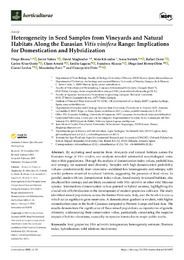Por favor, use este identificador para citar o enlazar este ítem:
https://hdl.handle.net/11000/38286Registro completo de metadatos
| Campo DC | Valor | Lengua/Idioma |
|---|---|---|
| dc.contributor.author | Rivera, Diego | - |
| dc.contributor.author | Valera, Javier | - |
| dc.contributor.author | Maghradze, David | - |
| dc.contributor.author | Kikvadze, Maia | - |
| dc.contributor.author | Nebish, Anna | - |
| dc.contributor.author | Ocete, Rafael | - |
| dc.contributor.author | Álvar Ocete, Carlos | - |
| dc.contributor.author | Arnold, Claire | - |
| dc.contributor.author | Laguna, Emilio | - |
| dc.contributor.author | Alcaraz, Francisco | - |
| dc.contributor.author | Rivera Obón, Diego José | - |
| dc.contributor.author | Lovicu, Gianni | - |
| dc.contributor.author | Farci, Massimino | - |
| dc.contributor.author | Obón, Concepción | - |
| dc.contributor.other | Departamentos de la UMH::Biología Aplicada | es_ES |
| dc.date.accessioned | 2025-11-18T12:24:09Z | - |
| dc.date.available | 2025-11-18T12:24:09Z | - |
| dc.date.created | 2025 | - |
| dc.identifier.citation | Horticulturae 2025, 11, 92 | es_ES |
| dc.identifier.issn | 2311-7524 | - |
| dc.identifier.uri | https://hdl.handle.net/11000/38286 | - |
| dc.description.abstract | By exploring seed samples from vineyards and natural habitats across the Eurasian range of Vitis vinifera, our analysis revealed substantial morphological variation within populations. Through the analysis of domestication index values, probabilities, and entropy, we assessed seed diversity. Samples with high domestication probability values—predominantly from vineyards—exhibited low heterogeneity and entropy, with similar patterns observed in natural habitats, suggesting the presence of feral vines. In parallel, seeds with low domestication index values, found mainly in natural habitats, also displayed low entropy and are likely associated with Vitis sylvestris or other wild Vitaceae species. Intermediate domestication values pointed to hybrid swarms, highlighting the crucial role of hybridization in the development of modern grapevine cultivars. The study identified mixed populations across the Iberian Peninsula, Italy, and the South Caucasus, which act as significant gene reservoirs. A domestication gradient is evident, with higher domestication rates in the South Caucasus compared toWestern Europe and East Asia. The results demonstrate the significance of these mixed populations as repositories of genetic diversity, underscoring their conservation value, particularly considering the negative impact of habitat alterations, especially in riparian forests due to major public works. | es_ES |
| dc.format | application/pdf | es_ES |
| dc.format.extent | 31 | es_ES |
| dc.language.iso | eng | es_ES |
| dc.publisher | MDPI | es_ES |
| dc.rights | info:eu-repo/semantics/openAccess | es_ES |
| dc.rights | Attribution-NonCommercial-NoDerivatives 4.0 Internacional | * |
| dc.rights.uri | http://creativecommons.org/licenses/by-nc-nd/4.0/ | * |
| dc.subject | feral | es_ES |
| dc.subject | grapevine | es_ES |
| dc.subject | Vitis sylvestris | es_ES |
| dc.subject | introgression | es_ES |
| dc.subject | heterogeneity estimate | es_ES |
| dc.subject | Shannon index | es_ES |
| dc.subject | hybridization | es_ES |
| dc.subject | wild relatives | es_ES |
| dc.subject | biodiversity | es_ES |
| dc.title | Heterogeneity in seed samples from Vineyards and Natural habitats along the Eurasian Vitis vinifera Range: implications for domestication and hybridization | es_ES |
| dc.type | info:eu-repo/semantics/article | es_ES |
| dc.relation.publisherversion | https://doi.org/10.3390/horticulturae11010092 | es_ES |

Ver/Abrir:
Heterogeinity vitis horticulturae r.pdf
1,39 MB
Adobe PDF
Compartir:
 La licencia se describe como: Atribución-NonComercial-NoDerivada 4.0 Internacional.
La licencia se describe como: Atribución-NonComercial-NoDerivada 4.0 Internacional.
.png)